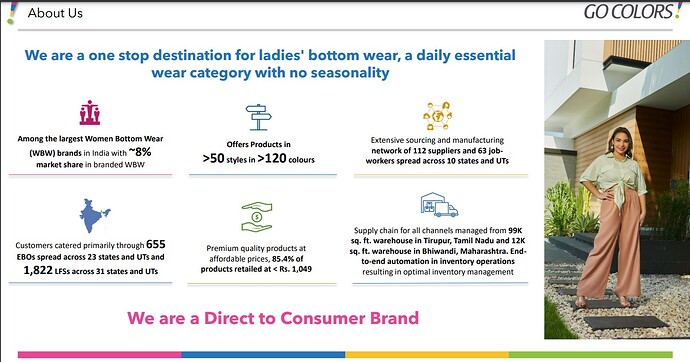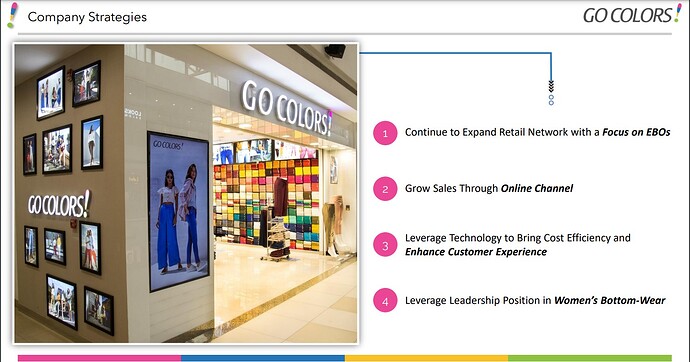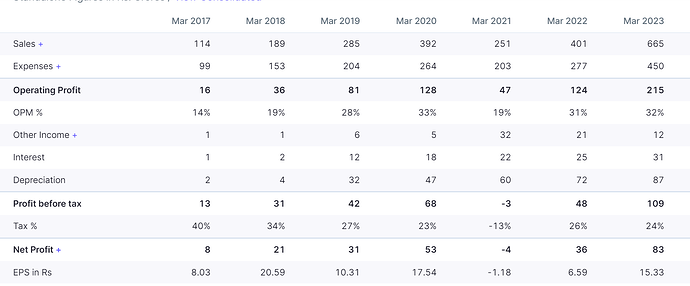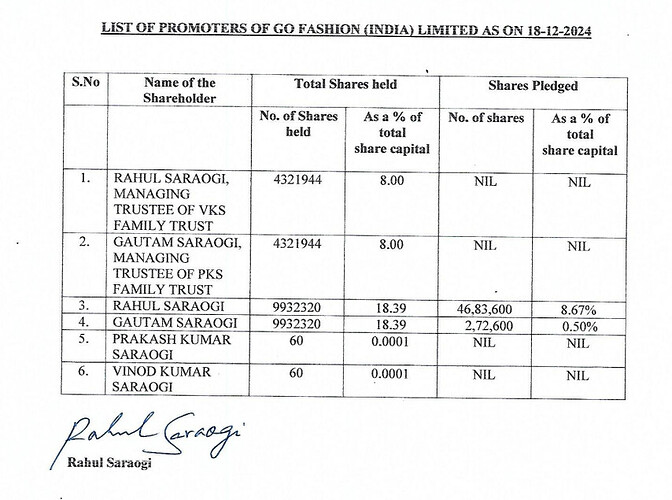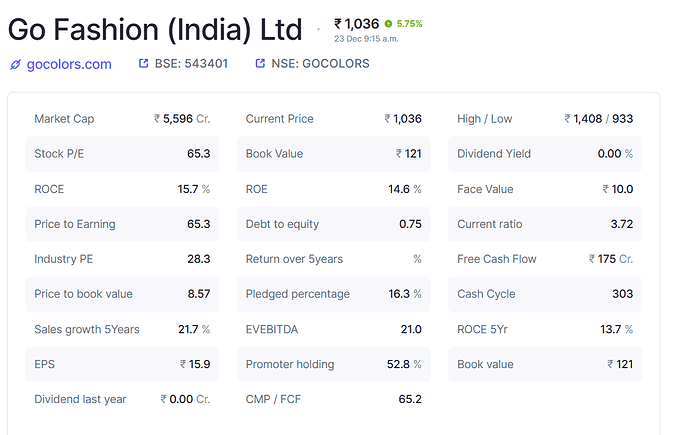Go Fashion is an interesting retail company that I’ve been studying for a couple of weeks. Since there was no thread about the company on VP, I thought I would start one.
The story
Gautam Saraogi, after his graduation joined his family business, which was focused on exporting garments. He soon realized that the business had low margins and was cyclical. It had also started facing losses in recent years. He wanted to build a more stable business with lesser competition. He narrowed it down to women’s bottom wear, as there was virtually no competitor focused exclusively on this market. Thus, Go Fashion was incorporated in 2010.
Understanding the Business
Go Fashion sells its products under the brand name Go Colors. It is among the largest women’s bottom wear brands in India with a market share of 9%. Go Colors tries to provide high quality product at reasonable prices ranging from Rs249 to Rs1,599, with around 83.3 percent of the products retailed under Rs1,049.
Their products include all kinds of women’s bottom wear - Churidar, Leggings, Dhotis, Harem Pants, Patiala, Palazzos, Culottes, Pants, Trousers, Jeggings, Denims etc. Company sold women bottom wear in 50 styles in more than 120 colors. Leggings & Churidars contribute around 50% of revenue.
Go Fashion sells its products through 3 channels. They operate through EBOs (Exclusive Business Outlets), LFS (Large Format stores like Reliance) and Online Sales. As of last financial year – this was the breakup.
EBO – 73.4% (655 stores)
LFS – 20.7% (1822 stores)
Online & Others – 5.9%
The focus is to expand EBOs. The CEO has goals of taking the current share of EBO sales to around 80% in a few years. The company follows the COCO (Company owned company operated) model for EBOs. Almost all of their EBOs are run by them.
Business Strategy
Cluster Based Approach – Go Fashion uses cluster-based expansion(presence of stores is same area/cities) to have better control over costs via inter-store stock movement. Instead of opening up multiple stores all over the country, the company focuses on opening as many stores as possible in one city first before moving to other places. This way they do not spread themselves too thin and can have better control over the stores. 56% of their stores are in the top 6 cities.
Minimal Spending on Marketing – Go Fashion spends much lesser than other consumer focused brands on marketing and advertising. Ad expense is 2.5%-4% of revenue and is mainly digital. Their stores are colorful and located in popular localities. The CEO believes the stores themselves work as an advertising tool for their brand.
No Discounting - 97% of the company’s products are sold on full price. Bottom wear being a core essential category & having limited print edition is insulated from changes in fashion trend and is acceptable across the country. There is thus low inventory risk. There was barely any inventory write off last year.
Things I like –
Good track record – Go Fashion has grown its revenues at a 5-year CAGR of 29% and it’s PAT at 31%, which included a couple of difficult years for retail business. The company has done so without taking any external debt. Since most of their sales come from EBOs, they also enjoy excellent gross margins of around 60% and ROCE of 20%(even when they are in an expansion phase).
Razor Sharp Focus – Go Fashion has shown exceptional focus by focusing solely on one category and ensuring they become a market leader there. There is no expansion of stores outside India, no deep discounting on e-commerce, no expansion into adjacent categories (which may have been very tempting). Go Fashion is solely focused on selling women’s bottom wear through their own retail stores.
Small player in a large unorganized market – Currently, the overall women’s bottom wear market is inclined towards the unorganised sector and in FY20 its share was at 77% and the organised share was at 23%, of which Go Fashion has 8% market share. There is a huge headroom for growth, with the company planning to add 125-150 EBO stores every year.
High repeat purchase - Products are core and essential to customers. There is no seasonality element to leggings and pants. The biggest risk faced by the apparel industry is the inventory risk which is quite low in women bottom wear/core segment.
Things I don’t like –
Retail Led Brands in Fashion is a tough business – While opening up your own stores does bring higher margins; it also comes with a huge added fixed cost. In case the business goes through a downturn, cash flow management becomes a big challenge. Very few brands have been able to do it successfully, and most of them are in the premium category (LVMH, Zara, etc) The industry is filled fashion brands that struggled in the retail space (Pantaloons, Shopper’s stop)
How much does brand matter in bottom wear? – While Go Fashion does have a first mover advantage and is a category leader, I’m not certain how much the brand matters when it comes to bottom wear. Do people care much about the brand of bottom wear they buy? I don’t know. The company does have wide range of bottom wear with various colors, but if the brand does not matter strongly, the customer can easily switch if cheaper or better products are available. All being said, they have grown their sales to 665 cr. in just over a decade, so they are doing something right.
Scuttlebutt – The reviews from everyone I’ve spoken to have mostly been positive. Their clothes are known for their good quality and especially for the availability of wide range of colours available (hence the name Go Colors). I was told that it is impossible to not find the shade of colour you’re looking for at Go Colors, implying their range of colours is that wide. I have also noticed multiple stores in my city, including at the airport.
Valuation – Overall there’s lots to like about the company, except the valuation. The stock price is at 1250, at a market cap of 6,750 crores. It trades at a PE of 80 and a Mcap/Sales of almost 10. The valuation is not reasonable by any means.
The story and growth potential also seem to be well known by the industry. The promoters own 52%, with FIIs and DIIs owning a combined 43%. Free float is slightly over 4%. The lowest the stock ever traded was at a PE of 60. It does not look like the stock will be available at a “decent” value anytime soon. I currently do not hold the stock, but it is on my watchlist.
Links –
Forbes article on Go Fashion
Latest Investor Presentation
1 hour interview on the journey of Gautam Saraogi
Couple of blogs
Go Fashion Analysis
Go Fashion Strategy

